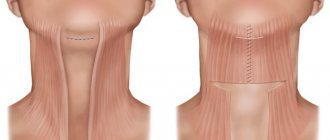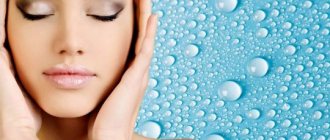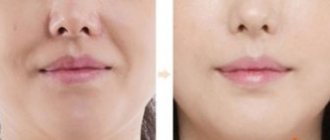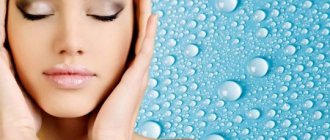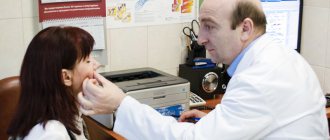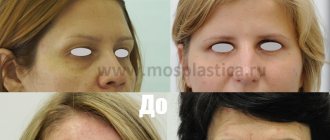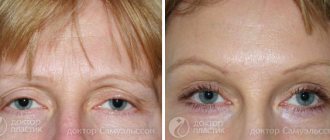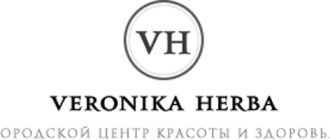Only empty, limited people do not judge by appearance. The true secret of life lies in the visible, and not in the hidden. Oscar Wilde
Why has a facelift become one of the most popular plastic surgeries today? The face is the calling card of a person. Based on it, conclusions are drawn about character, mood, approximate age and social status. However, it happens that appearance says something about a person that is not at all what he himself would like to say. Therefore, SMAS facelift has become almost a mandatory procedure for people of certain professions and standard of living. This technique can literally turn back time! A circular facelift helps not only to “throw off” 10-20 years, but to create a more optimistic and attractive image. After plastic surgery performed by Dr. Kudinova, the patient looks very natural, and the achieved effect lasts for at least 10-20 years.
Before and after SMAS facelift
All photos
Results Before and After FACIAL PLASTY Watch now
Each person and his appearance are individual: some require a circular facelift, while others need correction of individual zones. Sometimes you can get an excellent result with just a small lift of the forehead and eyebrows, or local surgical correction of the lower zone and neck.
When choosing a rejuvenation treatment, there are many factors to consider, including each patient's age, anatomy, and personal goals, vision, and expectations.
Book a consultation with Dr. Ekaterina Sergeevna Kudinova to learn more about SMAS facelift and other surgical and non-surgical rejuvenation methods. We recommend bringing your old favorite photos to your appointment.
Related video: facelift
Indications for surgical facial rejuvenation
Indications for comprehensive facial rejuvenation are visible, as they say, to the naked eye: aging of the eyelids, sagging of the middle zone and loss of facial contours.
With age, changes occur in the facial area. By restoring the correct location of subcutaneous tissue, removing excess fat, and excision of excess skin, surgical rejuvenation of the face and neck can eliminate the visible signs of aging. A facelift can be performed as a stand-alone operation or in combination with other surgical procedures, such as forehead and eyebrow plastic surgery, blepharoplasty and lipofilling. Any operation in the facial area is combined with a lift except rhinoplasty, since the combination of these operations due to large swelling can worsen the result of nose surgery. Therefore, facial plastic surgery and rhinoplasty should be performed as two different operations with an interval of at least two months.
A circumferential facelift can only be performed surgically; non-surgical rejuvenation procedures cannot achieve the same results, but they can delay the need for a facelift and also complement the results. All rejuvenating operations in the face and neck can be performed comprehensively and combined with operations such as blepharoplasty, forehead and eyebrow lifting, and lipofilling.
Circular facelift indications for surgery:
- Drooping (ptosis) of the skin of the forehead
- Pronounced age-related changes in the upper and/or lower eyelids
- Weakening and ptosis of tissue in the midface
- Significant excess skin forming deep folds located under the lower eyelids
- Deep folds from the nose to the corner of the mouth (nasolabial folds)
- Fat that has moved from the upper to the lower third of the face as a result of ptosis
- Loss of muscle tone in the lower part of the face, sagging cheeks, deformation of the oval of the face
- Loose skin and excess fat deposits under the chin and jaw, which can develop even in a person of normal weight
The patient underwent surgical facelift , eyelid plastic surgery and mid-zone lipofilling. This way we get total facial rejuvenation, popularly called a “circular facelift”.
Is a SMAS facelift right for you?
This operation can be recommended for both women and men, usually over 40 years of age. But in some cases (for example, after weight loss), facial plastic surgery can be performed at an earlier age. Anti-aging surgery may be recommended if you have one or more of the following problems:
- Visible signs of facial aging.
- Flaccid, sliding or sagging skin.
- Age-related muscle weakening.
- Change in volume and decrease in elasticity of the soft tissues of the face.
- Deep nasolabial folds.
- Changing the oval of the face.
- Wrinkles on the forehead, under the eyes, on the bridge of the nose.
- Excess fat deposits in the chin area.
- Unsightly contour of the lower jaw (“jowls”).
- Folds on the neck, double chin.
At the request of the patient and taking into account the indications and purposes of the operation, Ph.D. Ekaterina Sergeevna Kudinova can perform a facelift using an endoscopic or traditional method (more information about endoscopic facelift can be found here), as well as simultaneously with other corrections, for example, blepharoplasty, chin surgery or breast augmentation.
“Circular lift” is a complex of surgical procedures for total facial rejuvenation
All anti-aging surgeries in the face and neck area can be performed in combination with other anti-aging surgeries, such as blepharoplasty, forehead and eyebrow lifting, and lipofilling.
Since the aging process is extremely individual, age-related changes may occur unevenly, or affect some areas of the face more than others. A circular facelift allows you to solve all the problems of an aging face, as it involves a combination of the lift itself (as a rule, when we talk about a facelift, we mean its lower third) and a set of other anti-aging operations that allow simultaneous correction of all areas. In plastic surgery, zonal division of the face is common.
- For example, to correct age-related changes in the upper third of the face, lifting of the forehead and eyebrows is performed. This operation allows you to return the eyebrows to their original anatomical position, if desired, raise the lateral (outer) edge of the eyebrow, making the look more youthful and open. Often this procedure is combined with lipofilling of the upper eyelids, temporal region and eyebrows, thereby restoring the youthful anatomy of this part of the face.
- Eyelid surgery today includes not only excision of the skin, but also restoration of the smooth contour of the upper and lower eyelids. In our clinic, we achieve results by redistributing or introducing additional portions of fat in this area of the face.
- The middle zone is one of the first to age. Due to the heaviness of the cheeks, a large amount of subcutaneous fat, as well as weak muscle attachment in this area of the face, the middle area of the face is susceptible to ptosis. Depending on the severity of age-related changes, thread lifting (silhouette lift) methods may be offered for correction. As well as lipofilling of the midface with correction of the nasolacrimal groove, alignment of the eyelid-cheekbone transition, nasolabial fold and formation of high cheekbones.
- If necessary, it can be combined with liposuction of certain areas of the face to create the correct shape and harmonize features. To radically change the middle zone, it is possible to perform a check-lift operation, which allows you to eliminate sagging, tighten your cheeks, and restore volume in the cheekbones. Often this operation is associated with a change in the shape of the eyes - a slight elevation of the lateral corner of the eye occurs.
- A facelift is an operation aimed primarily at correcting age-related changes in the lower third of the face.
How is facial rejuvenation surgery performed?
There are many methods for performing this popular correction. The choice depends on the individual characteristics of the patient and his wishes. In our clinic, it is possible to carry out both an extended SMAS facelift and partial correction of individual areas, including brow lift, neck and chin plastic surgery, etc. (for reference, SMAS is the Latin abbreviation of the term PMAS - superficial muscular aponeurotic layer) .
SMAS lifting differs in the type and location of the incision:
- A classic facelift, in which incisions are made in front of the ears and along the hairline.
- An endoscopic technique is carried out through small punctures located so that they are not visible after the intervention (behind the ears, in the scalp, in the mouth, etc.).
In any case, the sutures are placed in such a way that after the end of the rehabilitation period, thin scars are completely invisible. For this purpose, the author’s “invisible seam” method of Dr. Kudinova is used. Ekaterina Sergeevna believes that one of the primary tasks of a plastic surgeon is to perform a facelift so that no visible traces of the intervention remain.
To restore the original volumes of various zones and preserve individual features, the author’s method of two-plane facial plastic surgery is used. During the operation, the doctor works with all tissues that need correction (subcutaneous lifting, SMAS lifting, deep subperiosteal lifting). In addition, Dr. Kudinova uses modern endoscopic technologies and methods of tissue fixation using endotins (special absorbable devices made of polylactic acid).
The operation is performed under general anesthesia and can last from 1 to 4 hours, depending on the complexity.
Types of circular lift
Classic face lift (rhytidectomy) . With this type of facial plastic surgery, the surgeon makes surgical incisions in the area of the scalp of the forehead, in the fold in front of the auricle and behind the ear. The technique involves manipulations to move, redistribute and give the desired position to tissues with subsequent tension of the skin. No work is done with the muscular frame during rhytidectomy, so the method is applicable mainly to patients with moderate age-related skin changes and without excess fatty tissue.
The operation is usually performed within 1-3 hours, under general or combined anesthesia.
The results of a facelift can last up to 5-7 years (if you follow all medical recommendations for facial care).
With a classic circular facelift, soft tissue and skin are plasticized, but the facial muscles are not involved. And after several years, the skin, under the weight of the muscles, is able to return to its previous (relaxed) state. Therefore, recently, surgeons are increasingly resorting to combined techniques that combine the techniques of classic facelift + SMAS lifting or endoscopic facelift and other techniques.
Deep circular lift (SMAS-lifting) . The technique combines elements of classic facelift and work with the deep layers of the face - muscles and tendons. (SMAS is an abbreviation for Superficial Musculo-Aponeurotic System, i.e. superficial muscular-aponeurotic system).
Manipulations with the SMAS layer make it possible not only to get rid of wrinkles and folds, but also to strengthen the muscular frame of the face and return it to its original relief.
The operation takes 3 hours (on average) and is performed mainly under general anesthesia.
The effect of a deep circular lift lasts much longer than that of a classic rhytidectomy - for 8-10 years or longer.
Circular lift. Photo before surgery
1 Photos before circular facelift
2 Photos before circular facelift
3 Photos before circular facelift
Circular lift. Photo after surgery
1 Photos after a circular facelift
2 Photos after a circular facelift
3 Photos after a circular facelift
Endoscopic facelift. With this type of facial plastic surgery, the surgeon works with the same tissues as with SMAS lifting. Only long incisions here replace miniature (1-2 cm) punctures, through which all manipulations are carried out using the finest endoscopic equipment and a video monitor. The doctor sequentially isolates the muscular aponeurotic layer and then tightens it along with the adjacent skin flaps.
The duration of the operation and the type of anesthesia depend on the scope of the intervention.
The advantages of endoscopic lifting are noticeable rejuvenation, invisible stitches and short rehabilitation. However, the technique is suitable mainly for people 35-45 years old. For older patients with pronounced deep wrinkles, more radical techniques are recommended that allow surgical excision of excess skin.
Combined facelift . When using a combined technique, the plastic surgeon touches not only the superficial tissues near the outer edge of the masseter muscle, but also the deep tissues up to the masseter muscle.
The use of different techniques (tissue mobilization at the SMAS level, movement of muscle-fibrous structures in different directions, excision of excess skin, neck lift, etc.) allows you to correct deep and superficial tissues, stretching them in different directions.
The duration of the operation depends on the complexity of the chosen techniques and can be 2-6 hours. Anesthesia - general.
Photo before a circular lift
1 Photos before circular facelift
2 Photos before circular facelift
3 Photos before circular facelift
Photo after a circular lift
1 Photos after a circular facelift
2 Photos after a circular facelift
3 Photos after a circular facelift
Do you need the best circular facelift surgeon in Moscow?
When it comes to such a complex and delicate area, choosing the right doctor is especially important. Plastic surgeon Ekaterina Sergeevna Kudinova is a recognized specialist in all types of aesthetic facial surgery. She has in-depth knowledge and experience in performing more than 10,000 plastic and reconstructive surgeries of various profiles. She has developed unique methods of surgical facial correction, including the technology of volumetric 2-plane facelift and the author’s “invisible seam” technology.
Plastic surgeon Kudinova uses the best experience and modern capabilities of plastic surgery to obtain maximum anti-aging effect and natural results without visible traces of surgical intervention.
What drugs are most often used for liquid tightening?
Various types of cosmetic fillers are used for this purpose. When choosing, the patient’s age, skin condition, injection site and other factors are taken into account. Therefore, a different regimen is selected for each patient.
For liquid tightening, a large number of drugs are used, which can be divided into groups:
- Poly-L-lactic acid (PLLA) preparations, the most famous of which is Sculptra / Sculptra Aesthetic. Unlike other fillers that simply fill in lines and creases, it works to address the cause of wrinkles. The drug stimulates the production of collagen protein, which makes up the skin framework, replenishing lost volume. Scuptra is used in the mouth area to correct nasolabial folds, marionette lines and chin wrinkles. As a rule, three procedures are performed, the results of which last for more than two years.
- Preparations based on hyaluronic acid - a substance that the skin loses with age. Among them, the most famous fillers are Juvederm and Restylane. This type of filler can be used to reduce wrinkles on the forehead, cheeks, jawline, and the appearance of wrinkles on the arms. They enlarge lips. The effect lasts from eight months to two years.
- Preparations based on calcium hydroxyapatite, the most common of which are the Radiesse line. This is also a completely natural drug that is found in teeth and bone tissue. Fillers of this type are used to tighten the skin on the cheekbones and cheeks, correct the shape of the nose, facial contours, and chin contours. They are used to fill wrinkles on the face and hands.
Liquid lifting goes well with other procedures:
- Administration of drugs based on botulinum toxin. Dynamic wrinkles (crow's feet, forehead lines, wrinkles) are treated with Botox or Xeomin, a muscle relaxant. The skin becomes even and smooth.
- Lipofilling is a transplantation of fat taken from the patient’s abdomen or thighs. This method allows you to restore large volumes of tissue, obtaining long-term results.
- PRP procedure – injections of platelet-rich plasma. Combining this method with a non-surgical facelift significantly improves the quality of the skin - fillers smooth out wrinkles and folds, and plasma injections work in deep tissues, causing them to rejuvenate and regenerate.
Only a cosmetologist with extensive experience can choose the right combination of liquid lifting with other procedures. In this case, you will be able to get the maximum effect.
Photo 1. Liquid facelift before and after
Photo 2. Liquid facelift before and after
How much does it cost to get a facelift in Moscow?
The price of the operation depends on the level of the specialist, the conditions of the clinic in which the correction is performed, and the medications used. The price for a circular facelift in Moscow varies widely.
The best methods, the best drugs, the best rehabilitation conditions determine the current prices for facial plastic surgery, which cannot be too low. However, Dr. Kudinova believes that the best balance of high quality surgery and reasonable prices for plastic surgery is in the interests of patients and the surgeon himself.
If you want to learn more about facelift surgery, sign up for a consultation on the website or call +7 (903) 790-69-58
Facelift. Report from the operating room and patient's diary
Our reader Larisa, 47 years old, underwent a circular facelift operation - facelift. She was operated on by surgeon Eduard Shikhirman. We tell you how it all happened and what the patient looks like after 3 weeks. In September, as part of the “Face-lifting with Dr. Shikhirman” project, we announced a search for a volunteer. And we received a surprising number of letters (surprisingly, because our audience is still mostly young). But the girls sent links to their mothers, and I understand them perfectly. Still, such an opportunity does not happen every day. We forwarded almost all letters to Dr. Eduard Shikhirman. (You can read more about it here.)
He invited those who at first glance might be suitable for surgery for a consultation.
This is how 47-year-old Larisa came to see Dr. Eduard Shikhirman.
This is what Larisa looked like then:
Larisa, 47 years old, photo before surgery
Larisa, 47 years old, photo before surgery
Larisa, 47 years old, photo before surgery
Comment by Dr. Eduard Shikhirman:
“I chose Larisa because she is a beautiful, well-groomed woman who, if you compete with her now, will remain young for a long time. Operations such as facelift must be done on time. Larisa is 47 years old. It is not too early and not too late - the operation should be done not according to age, but according to indications. There is clearly evidence here. Hernias on the lower and upper eyelids, ptosis - all this is visible to the naked eye. Can we wait? Of course you can. At least you can wait until you are 70 years old. And further too. The question is, is it worth the wait? What result do you want to get after?.. If you catch that moment, which, it seems to me, Larisa managed to catch, you can stay young for a long time. If you make it to 70 years old, no matter how hard I want, I won’t make you 40 years old.
At a consultation before surgery
In general, women usually begin to worry about their age - more precisely, about how they look, and that today they look worse than yesterday - at the age of 38-40. These experiences reach their peak at plus or minus 50 years. And they last up to 60. If during this period you surgically correct the changes that bother a woman, not only her appearance changes for the better, her life changes.”
At the pre-surgery appointment
Larisa's diary:
“I have never done any serious procedures. I didn’t even do any injections. A couple of years ago I was happy with everything except my weight. I went on a diet, lost 10 kilograms in 8 months, and my whole face literally sagged. And my eyes really bothered me. A year ago, I began to think about plastic surgery, I even went for a consultation with one doctor, he said - let’s get your eyes operated on first, and then come for a facelift... But I never got around to it. My daughter sent me a link to this site, to beautyinsider. I went for a consultation with Eduard Vadimovich. I immediately really liked the doctor: he spoke little, did not convince me of anything, did not make any exorbitant promises, but clearly knew what he was saying. When they told me that he had chosen me as a patient, I decided: I need to write an application for leave. If they give it to me (and I work as an accountant in a commercial bank, we are strict about this), then it’s fate, and I need to have an operation, and everything will be fine. And they gave me a vacation. From that moment on, I was worried about only two questions: how will I come out of anesthesia? And will I be able to come to work in 2 weeks? I no longer had any doubts about whether to have surgery or not. And - no, I didn’t consult with anyone and didn’t scour the Internet in search of information about facelift. I only read a little about the doctor - I was convinced that he was at least experienced (although this was already clear). Only my daughter and husband knew that I was going to have the operation. The daughter, of course, was in favor from the very beginning. And the husband only said: “If you decide, do it.” He didn’t try to dissuade him, for which I am very grateful to him.”
Day of surgery
Larisa's diary:
“On the eve of the operation, in general, I was not very worried. It was the weekend, and I, knowing that I wouldn’t be able to leave the house for a long time, loaded myself with household chores to the fullest. I slept normally, there were no panic attacks.
When I arrived at the clinic, however, I was still scared. But not enough to get up and run away :) I talked to the doctor again while he painted me like this:
Markings are made before the operation
Still, the personality of the doctor is of great importance. You either believe it or you don't. I believed in Eduard Vadimovich. But it was still a little scary.”
Commentary by Dr. Eduard Shikhirman
“Larissa has a rather thin, European face, and on such faces the result is always clearly visible. Her age-related changes, I would say, are average for women of her age, living in big cities, taking care of themselves (without fanaticism, but still). We decided to give Larisa a full face lift, including blepharoplasty of the upper and lower eyelids, mid-zone lifting, SMAS, and neck. We only didn’t touch the forehead area - he was already in good shape.”
Final preparations in the operating room. Team - surgeon, anesthesiologist, nurse - and patient
“When the patient is already on the operating table, I make another marking along which I will make the incisions.” Dr. Shikhirman's comment:
“We started by removing hernias on the upper and lower eyelids. Hernias must be removed correctly. Remove them, but not completely - partially redistribute them so that there are no failed eye sockets.
First, hernial protrusions are corrected, then excess skin is removed and muscle plastic surgery is performed - myopexy - to restore its tone. This is what guarantees lasting results. Hernias are removed from both the lower and upper eyelids. We also remove excess skin. In blepharoplasty, it is important to preserve the eye shape that the patient had. To avoid getting round eyes or an inverted eye... In fact, this is not such an easy operation as it seems at first glance. There are no “easy” operations at all.”
“The incision - and, accordingly, the seam - during blepharoplasty should extend slightly beyond the outer corner of the eye. It's like the bottom arrows. Otherwise your eyes will be round, like a dog's. But there is no need to be afraid of the seam. Subsequently it will not be visible. To do this, we apply special stitches - and in such a way that they are hidden in a natural fold.”
Here on a gauze napkin you can see the same removed hernias that created bags under Larisa’s eyes:
“After blepharoplasty - more precisely, almost simultaneously with it - we do a subperiosteal lifting of the middle zone. There are two techniques - endoscopic or open. In our case, it was open, since we did lower blepharoplasty, and through this access we also worked with the middle zone. No additional incisions were required here.
This lifting gives a more lasting and more natural result. The face does not become “cat-like” and flat. In general, our task is not to change the face, but to restore it. Remove those age-related changes that have appeared. Therefore, I choose methods that will allow me to do this and the result will be as natural as possible.
On the neck, to remove the double chin and create a clear, “youthful” angle, liposuction is performed - excess subcutaneous fat is removed and platysmaplasty is performed. We also remove the fat behind the platysma. All this is done through a small, about 2 cm incision under the chin. The seam there will also not be visible.
“Then a SMAS lift is done. SMAS is the superficial muscular aponeurotic layer. In this kind of operation, from my point of view, it makes sense to work with him. If you work only with the skin, the result will be much less durable. The skin will sag again very soon. With SMAS lifting, muscles and fascia are also lifted. In general, I don’t like the word “lift”. There is no need to tighten anything. The task is not to stretch, but to set the fabrics in place and remove excess skin. If the “tightening” is done correctly, there will be no “tightening” at all. But since there is no synonym for this word in the Russian language, we will use it, no matter what.
The sutures are placed in the scalp. Of course, they will not be visible.
At the end of the operation, we install a drain to minimize bruising and to speed up the recovery period.
Then a bandage is applied. In general, the result is already visible - well, at least to professionals. The face is already different, young, fit. Modern dressings also reduce swelling and prevent bruises.
That's it, the operation is over. After this, Larisa will spend an hour in the intensive care unit, where she will be taken out of anesthesia and her general condition will be monitored. Then she will be transferred to a ward. The next day I will examine her and, hopefully, we will let Larisa go home.
The operation took 2.5 hours. I'm pleased with how it went. The recovery period will last several weeks. In 2-3 weeks, Larisa, I hope, will be able to go to work.”
Larisa's Diary
“When I came to my senses after the anesthesia, there was no pain. There was a tight bandage on my face and some stickers on my eyes, so I looked at the world through narrow slits. It was uncomfortable, but not painful. I called my husband, said that everything was ok, and fell back into sleep. In the evening, the doctor who assisted Eduard Vadimovich during the operation came and asked if I needed sleeping pills. I refused, and at 2 am I woke up and realized that I still had to. I called a nurse - she immediately appeared, gave me a pill, and I fell asleep. In general, the clinic is good, the conditions are excellent, the staff are all very friendly, nice, and responsive. I felt almost like a princess. Only with a bandaged head."
Second day after surgery
Larisa's Diary
“The doctor examined me this morning. He changed my bandage. I asked how things were going. I said that it was great, although I didn’t look particularly great, to put it mildly:
Less than a day has passed since the operation
Less than a day has passed since the operation
After the examination, the doc said that everything was fine and offered to choose: spend another day in the clinic or go home. I said - go home! I called my husband, he came and picked me up. He was probably scared... well, at least he was wary, but he didn’t show it.”
Commentary by Dr. Shikhirman
“Larissa did well: she tried not to lose her sense of humor. In general, I noticed: the more optimistic the patient is about life, the faster and easier his recovery period is. The outcome of the operation depends on the doctor, but how quickly the rehabilitation will take place depends on the individual characteristics of the patient. Including his character.”
Third, fourth and fifth days after surgery
Larisa's Diary
“For the first time in many years I’m spending my holidays at home. And I’m very worried about what I’ll be like when I go to work, because I only have 12 days left. I don’t have severe pain, and I didn’t have any on the second or third day. The doctor, Eduard Vadimovich’s assistant, called several times and asked about my well-being. It was also nice that I had Eduard Vadimovich’s mobile phone. I didn’t use it, but it was important for me to know that if something happened, I could call.
Depression hit me on the fifth day after the operation. I looked at myself in the mirror and burst into tears. The face is yellow, swollen, the nose is large, the eyes are narrow, the mouth is crooked, the hat-band on the head is terribly tired, I want to wash my hair, but I have no strength. I tried to remember myself before the operation - I was definitely better! Why did I do all this?! True, the consolation is that there are no jowls.
Eighth day after surgery
Larisa's Diary
“The swelling went away, and along with it, the depression. The mood is just great. Today I had a consultation, the sticker strips were removed from my eyes, and the hated bandage cap was removed from my head. Allowed to wash my hair!!!
I look in the mirror no longer with horror, but with curiosity.
And they said that in 4 days the stitches would be removed.”
Twelfth day after surgery, removal of sutures
Larisa's Diary
“I was a little afraid of this, but it turned out that everything was not so scary at all. We can say that this is one of the most painful moments during the entire operation, but it is quite tolerable.
The stitches, as the doctor said, turned out neat and invisible: He praised me and smiled all the time - it was obvious that he himself liked the result.” This is what I looked like 12 days after surgery after the stitches were removed:
If they had shown me these photos, I would never have believed that so little time had passed since the operation.”
Commentary by Dr. Shikhirman
“Larisa is recovering very well. Of course, there is still swelling, and sensitivity is impaired in some places. Larisa is worried about all these things. But this is all completely normal. Now I can definitely guarantee that in 3 months, when we see the final result, she will like it.”
Three weeks after surgery
Larisa's Diary
“The operation took place on October 19. On November 2, exactly two weeks later, I went back to work! As usual, I applied only Clarins foundation, powder and mascara to my face. All my colleagues noticed that something had changed in me, but no one could really understand what it was. A variety of assumptions were made: did she cut her hair? did you dye it? Did you style your hair differently? Not a single person guessed that I actually had a facelift. Someone else joked: “I wish I could go on vacation like that and look 10 years younger!”
I told the truth only to my closest colleagues. And then, without any details - “I just did a lift of the middle third of the face.” Now it seems to me that it’s so “simple.”
One of the unpleasant sensations - if you find fault with yourself - is a certain feeling of skin tightness. But it is getting smaller every day. I do gymnastics for my lips - I pronounce all these vowel sounds “O-o-o-o”, “U-u-u-u-u”, “Yu-u-u-u.” There are no bruises at all. The scars are still visible on the eyes - thin, not noticeable.
I’m reviewing the photos that I took on my iPhone at the request of a beauty insider - only the dates on them convince me that it all happened so recently.
Now I look like this:
And, most importantly, I’m not at all afraid to look at myself in the mirror. We have something like this hanging in the elevator at home, big, merciless, brightly lit. Previously, I always tried to stand with my back to him. And now, on the contrary, I look and look until I reach my 6th floor. It’s even a pity that I don’t live in the last one.”
Dr. Shikhirman's comment:
“In three months Larisa will be even better, you’ll see.”
PS. We thank Dr. Eduard Shikhirman for the brilliant operation and help in preparing this material. You can make an appointment with him for a consultation by calling the numbers listed on the website. We promise to watch how Larisa’s face changes. And we are very glad that she is happy!
When are the results of the procedure visible?
The results of the introduction of fillers are visible immediately. Since fillers not only restore volume, but also start the rejuvenation process, they will improve over another 3-6 months.
When using drugs based on L-polylactic acid, you will have to wait longer for results, since the body needs to produce collagen, which leads to tissue tightening.
Liquid lifting is a safe, low-traumatic, effective procedure, the popularity of which is growing along with other non-surgical methods. This is an excellent option for those who want to get a rejuvenating effect without surgery.
